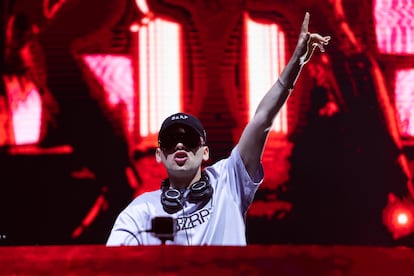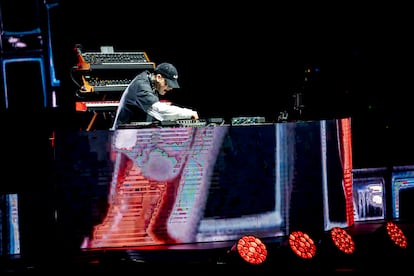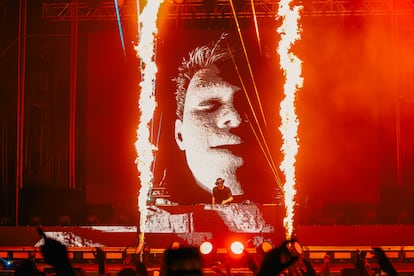The rush of an hour inside Bizarrap’s hit machine
The Argentine, one of the ‘it’ musicians of the moment, finishes a 12-concert tour in Spain on August 22. It’s hard to find a concert with so many international hits sung in Spanish: Shakira, Quevedo, Duki, Nathy Peluso...


There are more than a few hits at Bizarrap’s concert at Marenostrum, an idyllic amphitheater overlooking the sea in Fuengirola (Málaga, Spain). The Argentine began the night with the Session that lent his project credibility: his song with Nathy Peluso. His compatriot appeared robotized on a screen that emitted various stimuli throughout the concert. That’s another secret to his success, as one of the attendees, Carlos Paños, 24, put it: “It was great from beginning to end. In addition to the music, I loved the lighting design and the projections.”
Bizarrap (born Gonzalo Julián Conde), who turns 25 on August 28, is the star of the Boombastic music festival tour (with stops in other Spanish cities, including Madrid, Alicante, Asturias and the Canary Islands, in addition to Málaga), which showcases urban music — the genre that brings together everything that sounds like reggaeton, rap and Latin electronic music and whose followers are mainly teenagers and twenty-somethings.
Since June, Bizarrap has completed a dozen concerts in Spain. His tour ends on August 22 in Ibiza. According to elplural.com, he has received an average of €200,000 (about $218,000) for his performances. Is that a lot? It’s relative; another DJ, David Guetta, received €900,000 ($981,000) for his August 20 show in Vigo, Spain. The 55-year-old Frenchman has reigned supreme among commercial DJs for years; today, Bizarrap is the closest example for young audiences. One DJ has already reached his peak, while the other is rising meteorically, and it is not clear how far he can go.

Bizarrap has a winning repertoire for his concerts: his famous Sessions, an initiative that began in 2018 and consists of songs in which he provides the music, and a guest artist takes care of the lyrics and performance. The songs don’t have titles; they are numbered chronologically. The latest one, from June this year, featuring Puerto Rican Rauw Alejandro (a regular in the society pages these days) is Bizarrap Music Sessions Vol. 56.
That raises the question: how can Bizarrap successfully hold a concert based on songs with different performers who are not on stage? The Argentine performs alone, situated on a platform that is like a DJ booth with wings. On stage, he offers an electronic music session for the whole family, as demonstrated in Fuengirola and corroborated by Vera Serrano, a 26-year-old fan who attended Boombastic with three friends: “I see myself [enjoying] a DJ session in concert that I would never have imagined [I would like], because I’m not a big fan of techno sessions... But here I am, enjoying it. They’re all hits that I’ve heard a thousand times.”

Bizarrap barely spoke during the show, and when he did, he only uttered clichés of concert euphoria: “Are you ready?”, “Everybody jump!” or “Let’s go, Fuengirola!” Dialectics are not his forte. Nor does he draw an entirely youthful audience, as the concerts include families looking to join in the revelry as well. For what feels like the first time, one can attend a concert with so many international hits in Spanish: the Sessions of Villano Antillano, Nathy Peluso, Paulo Londra, Duki and Residente. The spirit of the concert is encapsulated by Residente’s refrain “Esto lo hago pa’ divertirme, pa’ divertirme” [I’m doing this to have fun, have fun]. The numbers of views on YouTube and listens on Spotify that Bizarrap has are staggering.
The head of a white she-wolf appears on a giant screen. Her eyes are yellow. The stage is tinged pink. Bizarrap, perched in his spaceship/DJ booth, presses a button, and we hear: “Pa’ tipos como tú, uh, uh, uuuuh” [For guys like you, uh, uh, uuuuh]. From there, the 15,000 people who fill the venue unceremoniously hurl insults at Gerard Piqué — Shakira’s ex and the target of her hit song with Bizarrap.
Maria, Luis and Pablo (7, 9 and 12 years old) blast the former football player in the company of their parents. They all dance. The whole family seems to despise him; the audience joyfully insults him. Shakira has no idea where she is: she only appears on the screen as a drawing, the same one that appears in the video of the song, from the famous Sessions 53.

The new life that the Argentine breathes into the songs is one of the keys to the appeal of Bizarrap’s concerts: he cuts the songs, mixes them, transforms them... None of the tunes sounds in full: it is about creating lures every 30 seconds, replacing one sound and visual incentive with another. Quickly. Bang, bang. Some songs seem new, but they’re always recognizable, either through the chorus or the main rhythm. For example, some audiences could tire of more rap-style pieces, so Bizarrap speeds them up with a danceable base (e.g., songs by Paulo Londra and Duki). The Argentine accompanies the songs with arm movements, puts on and takes off his headphones, presses little buttons, touches the keys... Around him, licks of fire appear, fireworks explode, smoke cannons go off... An obligatory show to make up for the lack of musicians and singers. The concerts are short — exactly 60 minutes — so there’s no time to get bored. Bizarrap’s own image is also suggestive; he doesn’t show his face, which is covered with silver glasses and a dark cap. At the end, he comes out of the DJ booth, wearing a black T-shirt and revealing that, like many of the concertgoers, he is wearing athletic shorts.
He could have done without performing the second-to-last song, Tres estrellas en el conjunto [Three Stars in the Set], the song he and Duki composed to celebrate Argentina’s triumph in the recent World Cup in Qatar. The song offers little outside the soccer context. Instead of taking out an Argentine flag, he displayed Malaga’s purple and green flag; needless to say, it went over well. The finale was Quédate [Stay] as Sessions 52 is known; Bizarrap recorded it last year with Quevedo in the Canary Islands. It was 2:30 a.m. and it wasn’t a song; it was unrestrained music. The only thing missing was one of those giant hands in the audience with the words “great song” emblazoned on it.
Sign up for our weekly newsletter to get more English-language news coverage from EL PAÍS USA Edition
Tu suscripción se está usando en otro dispositivo
¿Quieres añadir otro usuario a tu suscripción?
Si continúas leyendo en este dispositivo, no se podrá leer en el otro.
FlechaTu suscripción se está usando en otro dispositivo y solo puedes acceder a EL PAÍS desde un dispositivo a la vez.
Si quieres compartir tu cuenta, cambia tu suscripción a la modalidad Premium, así podrás añadir otro usuario. Cada uno accederá con su propia cuenta de email, lo que os permitirá personalizar vuestra experiencia en EL PAÍS.
¿Tienes una suscripción de empresa? Accede aquí para contratar más cuentas.
En el caso de no saber quién está usando tu cuenta, te recomendamos cambiar tu contraseña aquí.
Si decides continuar compartiendo tu cuenta, este mensaje se mostrará en tu dispositivo y en el de la otra persona que está usando tu cuenta de forma indefinida, afectando a tu experiencia de lectura. Puedes consultar aquí los términos y condiciones de la suscripción digital.
More information
Archived In
Últimas noticias
There is as much life left to discover on planet Earth as that which is already known
Dozens presumed dead, around 100 injured in fire at Swiss Alps bar during New Year’s celebration
Is porn for women different from conventional porn? We spoke to those who make it
Cartagena de Indias is sinking: What can the city do to mitigate it?
Most viewed
- Reinhard Genzel, Nobel laureate in physics: ‘One-minute videos will never give you the truth’
- David King, chemist: ‘There are scientists studying how to cool the planet; nobody should stop these experiments from happening’
- Sinaloa Cartel war is taking its toll on Los Chapitos
- Oona Chaplin: ‘I told James Cameron that I was living in a treehouse and starting a permaculture project with a friend’
- The Interoceanic Train, the Mexican alternative to the Panama Canal










































